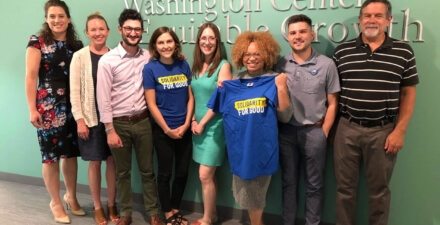Brad DeLong: Worthy reads on equitable growth, June 28–July 3, 2019
Worthy reads from Equitable Growth:
- Watch Heather Boushey discuss “How can we better measure growth beyond GDP.”
- Equitable Growth’s recent tweet informs me that Oregon is leading on family and medical paid leave: “Congratulation to Oregon for passing one of the most comprehensive paid family and medical leave policies in the nation. To learn more about the implications of paid family leave on American families and employers, check out our factsheet.”
- Heather Boushey is walking the walk in her tweet about the new staff union at Equitable Growth: “We believe that having a staff union at Equitable Growth will make us a stronger organization and look forward to working with union members.”
- While there has been a lot of noise about the changing short-run U.S. economic outlook over the past year, in actuality very little has changed. The U.S. economy continues to grow slightly above its trend rate of 2 percent per year or so, with no outbreak of inflation and with a roughly 1-in-5 chance of seeing a recession begin within the year. Read my “Weekly Forecasting Update,” in which I write: “It is still the case that: [1] the Trump-McConnell-Ryan tax cut has been a complete failure at boosting the American economy through increased investment in America … [2] U.S. potential economic growth continues to be around 2 percent a year … [3] There are still no signs the United States has entered that phase of the recovery in which inflation is accelerating.”
Worthy reads not from Equitable Growth:
- To say that there are now trends for factories to locate close to demand is not an alternative source of regional comparative advantage and disadvantage but rather an amplifier of other sources. Ultimately, customers are located in regions that have regional exports. A region that does not have large regional exports—and the prospect of growing more—will not be attractive to firms making long-run decisions and attempting to locate where their customers will be. It is likely to be a very uphill climb. I do not see this as a “silver lining” at all. Read Rana Foroohar, “Silver Lining for Labour Markets” (subscription required), in which she writes: “Globalisation … bottom of … reasons that labour’s share of national income has declined … The biggest reason … supercycles in areas … which favour capital over labour. … Automation and the speeding up of capital substitution because of technological shifts have hurt traditional industrial areas disproportionately … A mere 25 cities and regions could account for 60 percent of U.S. job growth by 2030 … Tech hubs will benefit, of course, as will commodity-rich areas and tourism centres catering to the wealthy. But so will … regions … capitalis[ing] on a silver lining … being closer to customer demand … Companies such as Nike and Adidas have built highly automated ‘speed-factories’ … to roll out the latest styles faster and more cheaply.”
- I do not understand this alternative. Tapping into global markets is great—if you have something to sell. But if low-wage labor is no longer a powerful source of potential comparative advantage, what then do poor countries have to sell that could jump-start development? There is labor, there is capital, there is expertise, there is your natural resource base. Poor counties are poor because they lack capital and expertise. And, as for natural resources, well, the “resource curse” is a phrase often heard for good reason. Read Michael Spence, “The ‘Digital Revolution’ of Wellbeing,” in which he writes: “In the early stages of development … labor-intensive process-oriented manufacturing and assembly has played an indispensable role … Advances in robotics and automation are now eroding the developing world’s traditional source of comparative advantage … E-commerce platforms … [are] the real prize in the global marketplace. Only if digital platforms could be extended to tap into global demand would they suggest an alternative growth model (provided that tariffs and regulatory barriers do not get in the way).”
- That Martin Feldstein was certain that we could determine and then agree upon what good public policies were was always heartening and raised my confidence that we could make a better world. Read Larry Summers, “The Economist Who Helped Me Find My Calling,” in which he writes: “Working for [Feldstein], I saw what I had not seen in the classroom: that rigorous and close statistical analysis … can provide better answers to economic questions, and possibly better lives … Marty was a magnet for talent … Marty cared about people’s economic analysis, not their political affiliation. That is why he mentored stars like Jeffrey Sachs and Raj Chetty, who disagreed with him on many questions.”







